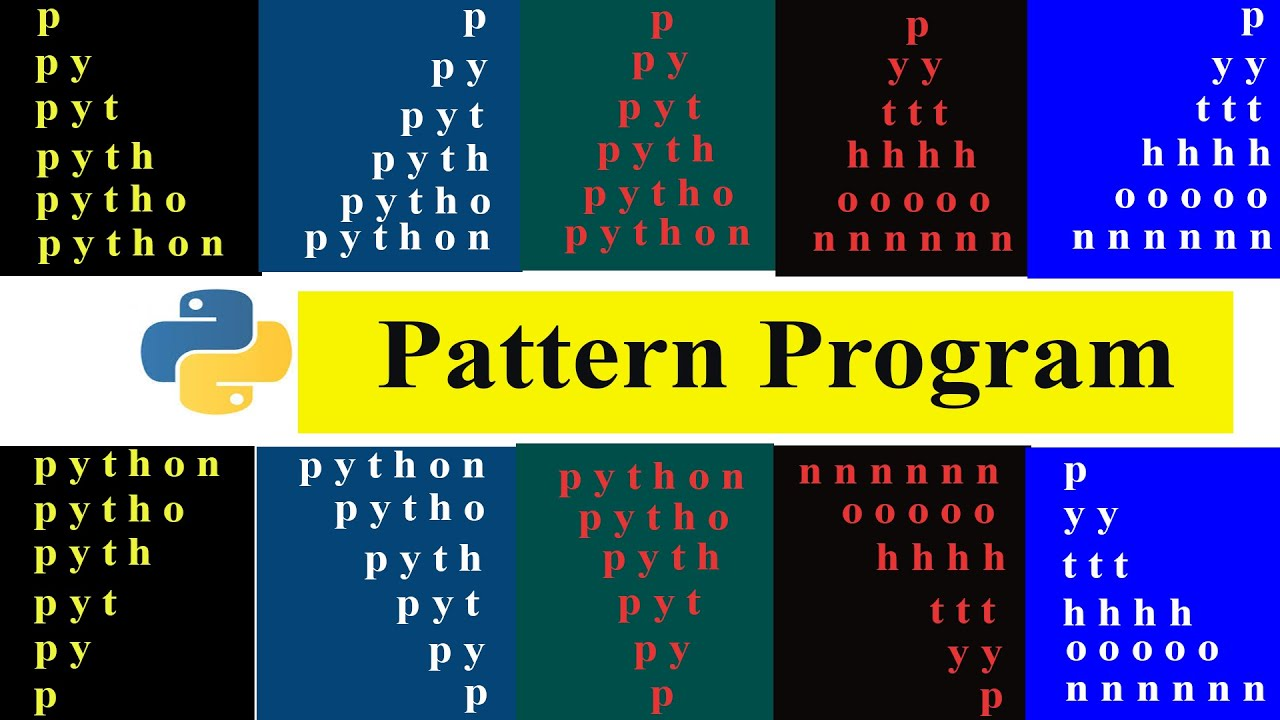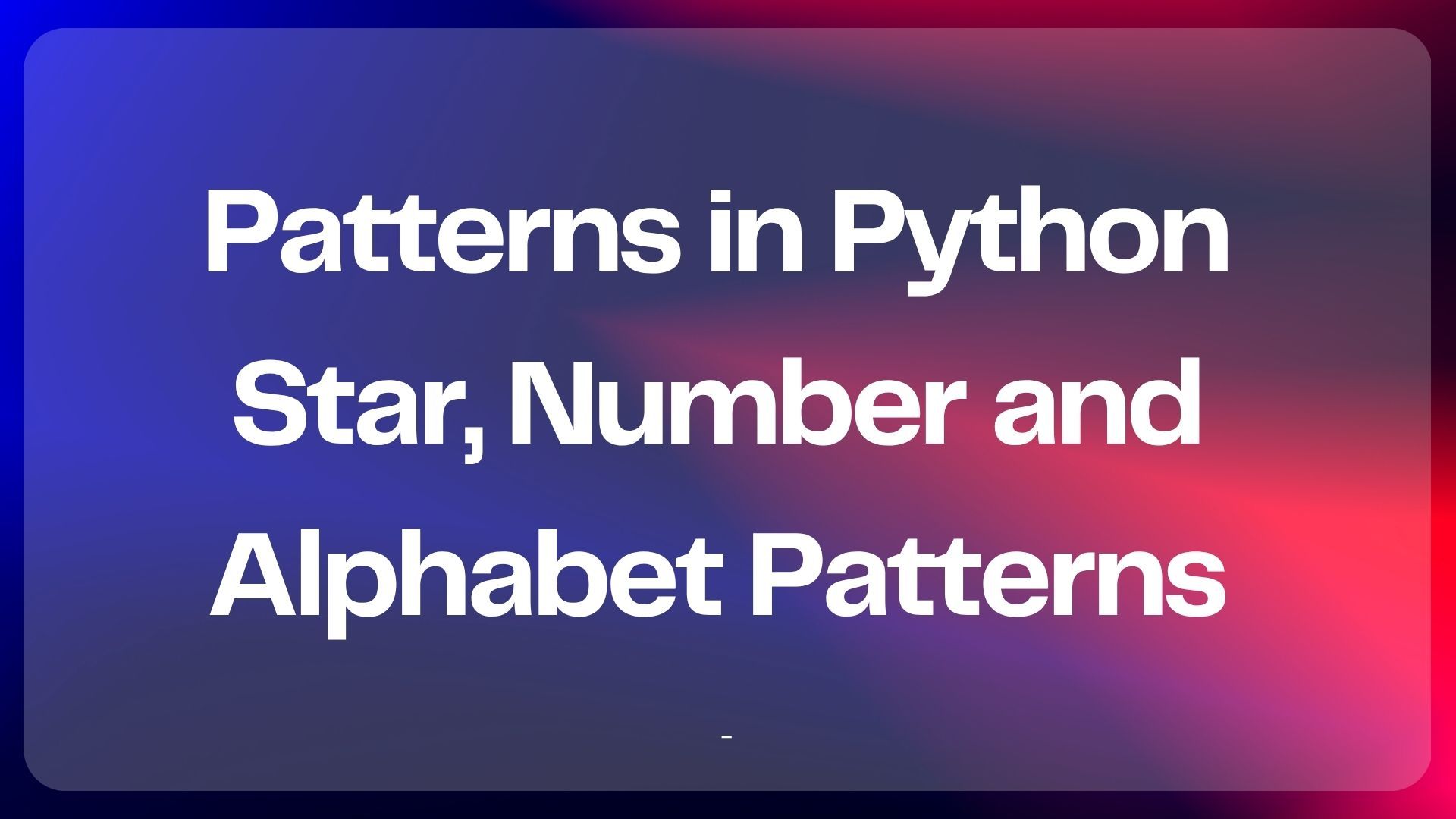Learning programming through practical, fun examples is one of the best ways to understand logic and control structures. One such example is pattern printing in Python. Whether you're printing stars, numbers, or alphabets, the concept of patterns in Python helps you develop strong problem-solving skills.
If you're currently enrolled in a Python Programming Course in Noida or just starting out on your own, mastering pattern programs will prepare you for coding interviews and logic-based exams.
This article will guide you through various types of Python pattern programs:
- Star patterns
- Number patterns
- Alphabet patterns
We’ll break down each pattern type, explain the logic, and provide well-commented code.
Star Patterns in Python
Star patterns are the most common type of patterns students encounter when learning loops.
1. Right-Angled Triangle Pattern
*
* *
* * *
* * * *
rows = 4
for i in range(1, rows+1):
for j in range(i):
print("*", end=" ")
print()
Logic:
- Outer loop runs from 1 to rows
- Inner loop prints * equal to the current row number
2. Inverted Right-Angled Triangle
* * * *
* * *
* *
*
rows = 4
for i in range(rows, 0, -1):
for j in range(i):
print("*", end=" ")
print()
3. Pyramid Pattern
*
* *
* * *
* * * *
rows = 4
for i in range(rows):
print(" " * (rows - i - 1) + "* " * (i + 1))
4. Diamond Pattern
*
* *
* * *
* *
*
rows = 3
# Upper half
for i in range(rows):
print(" " * (rows - i - 1) + "* " * (i + 1))
# Lower half
for i in range(rows-2, -1, -1):
print(" " * (rows - i - 1) + "* " * (i + 1))
Number Patterns in Python
Number patterns help you practice numeric sequences and loop logic. These are commonly asked in placement tests and assessments in a Python Programming Course in Noida.
1. Increasing Number Triangle
1
1 2
1 2 3
1 2 3 4
rows = 4
for i in range(1, rows + 1):
for j in range(1, i + 1):
print(j, end=" ")
print()
2. Repeating Row Number
1
2 2
3 3 3
4 4 4 4
rows = 4
for i in range(1, rows + 1):
for j in range(i):
print(i, end=" ")
print()
3. Number Pyramid
1
1 2
1 2 3
1 2 3 4
rows = 4
for i in range(1, rows + 1):
print(" " * (rows - i), end="")
for j in range(1, i + 1):
print(j, end=" ")
print()
4. Pascal’s Triangle (Optional Advanced Pattern)
1
1 1
1 2 1
1 3 3 1
def factorial(n):
return 1 if n == 0 else n * factorial(n-1)
rows = 4
for i in range(rows):
for j in range(rows - i + 1):
print(" ", end="")
for j in range(i + 1):
print(factorial(i) // (factorial(j) * factorial(i - j)), end=" ")
print()
Alphabet Patterns in Python

Alphabet patterns help learners deal with ASCII values and practice looping in creative ways.
1. Alphabet Triangle (A to Z)
A
A B
A B C
A B C D
rows = 4
for i in range(1, rows + 1):
for j in range(i):
print(chr(65 + j), end=" ")
print()
2. Repeating Alphabet Per Row
A
B B
C C C
D D D D
rows = 4
for i in range(rows):
for j in range(i + 1):
print(chr(65 + i), end=" ")
print()
3. Alphabet Pyramid
A
A B
A B C
A B C D
rows = 4
for i in range(1, rows + 1):
print(" " * (rows - i), end="")
for j in range(i):
print(chr(65 + j), end=" ")
print()
4. Inverted Alphabet Pyramid
A B C D
A B C
A B
A
rows = 4
for i in range(rows, 0, -1):
for j in range(i):
print(chr(65 + j), end=" ")
print()
Why Learn Patterns in Python?
Pattern problems are excellent for beginners, especially those pursuing a Python Programming Course in Noida, because they:
- Reinforce loop concepts (for, while)
- Build logical thinking
- Improve debugging skills
- Sharpen coding speed for interviews
- Strengthen your understanding of string and numeric manipulations
Advanced Pattern Challenges in Python
Once you're comfortable with the basics, you can challenge yourself with more complex patterns in Python. These types of problems not only help in coding interviews but also prepare you for advanced algorithmic thinking.
Hollow Star Pattern
* * * * *
* *
* *
* *
* * * * *
n = 5
for i in range(n):
for j in range(n):
if i == 0 or i == n - 1 or j == 0 or j == n - 1:
print("*", end=" ")
else:
print(" ", end=" ")
print()
Logic: The stars are printed only on the boundary, first row, last row, first column, and last column. Inside rows are padded with spaces.
Hollow Pyramid Pattern
*
* *
* *
* *
*********
rows = 5
for i in range(rows):
for j in range(rows - i - 1):
print(" ", end="")
for j in range(2 * i + 1):
if j == 0 or j == 2 * i or i == rows - 1:
print("*", end="")
else:
print(" ", end="")
print()
Explanation: This pyramid uses spaces in the middle and stars only on the edges to create a hollow appearance.
Real-World Applications of Pattern Programs
Although pattern problems may seem academic or purely for practice, they have real-world value too, especially in visual computation, screen rendering, and layout algorithms.
UI and Graphic Programming
Patterns play a role in designing icons, layout elements, and console-based user interfaces. In simple games or command-line applications, patterns are used to represent objects or terrain.
Algorithm Development
Learning to print structured patterns in Python helps in developing algorithms for matrix manipulation, spiral traversals, and symmetrical designs.
Placement and Interviews
In coding rounds of companies like Infosys, TCS, Wipro, and Tech Mahindra, you’ll find patterns in Python used to test loop understanding and output prediction.
If you're pursuing a Python Programming Course in Noida, your institute may include pattern-based coding tests during mock interviews or final evaluations.
Practice Problems to Try Yourself
Want to strengthen your logic? Try solving the following without looking at the solution:
- Butterfly Pattern
- Hourglass Number Pattern
- Right-Aligned Triangle
- Heart Shape Using Stars
- Zig-Zag Pattern Using Numbers
Try implementing these patterns on your own. These help you grasp loop control, character positioning, and symmetry-based logic.
How Pattern Skills Help in Career Growth
If you’re aiming for a career in software development, web development, or data science, learning patterns in Python equips you with important foundational skills.
For Job Interviews:
Many job interviews start with logic-building questions. Being able to write patterns shows:
- Strong control over loops
- Understanding of nested structures
- Attention to formatting and output accuracy
For Coding Competitions:
Platforms like HackerRank, CodeChef, and LeetCode often include pattern questions for beginners. A solid grasp of these will boost your confidence.
In Python Courses:
If you're enrolled in a Python Course in Noida, expect assignments and quizzes that include pattern generation using nested loops and conditionals.
Tools and Platforms for Practicing Patterns
Here are some platforms that help you learn and practice:
Use these tools to experiment with your own variations of the patterns discussed above.
Tips for Mastering Python Patterns
- Understand Loop Flow: Visualize how the outer and inner loops interact.
- Use Pen & Paper: Dry-run the logic before coding.
- Experiment with Values: Try different ranges and characters.
- Practice ASCII Operations: Especially for alphabet patterns using chr() and ord().
- Time Yourself: Practicing under time constraints helps during exams.
Conclusion
Understanding and practicing patterns in Python is a foundational step in becoming a confident programmer. Whether you're working on star patterns, number patterns, or alphabet patterns, each variation teaches you something unique about loops, conditions, and output formatting.
If you're serious about building your logic and preparing for technical interviews, start practicing these patterns regularly. They’re often part of assignments, quizzes, and exams in any Python Programming Course in Noida.
So go ahead, challenge yourself with a few patterns daily. Your logic-building skills will thank you later!
